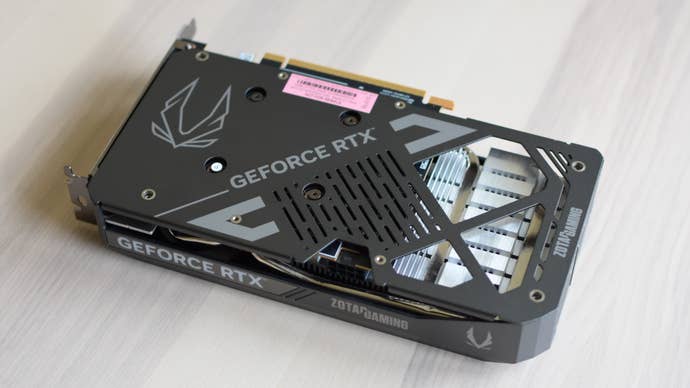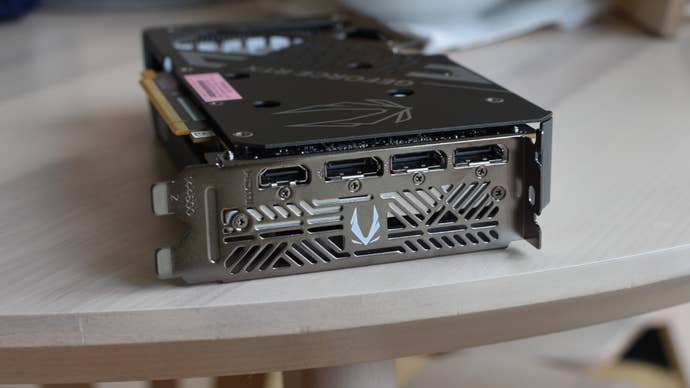There was a time when I’d be chuffed to bits to be clicking a new entry-level graphics card into its PCIe home. Think back to the GTX 1050 Ti or the Radeon RX 570 – these weren’t just great GPUs because they were accessible, but because you could practically feel the scrappiness bouncing off their circuitry. Like barking little chihuahuas, throwing down against a pack of mastiffs. You can see they’re no match for the bigger boys. But you kind of love them for not caring.
The Nvidia GeForce RTX 5050 is no such card. It is the most affordable of the RTX 50 series, undercutting the RTX 5060 by about £40 / $50, and it does come with a full set of DLSS 4 tools including Multi Frame Generation (MFG) support. Its performance, sadly, leans more slow than scrappy, and it isn’t even really that cheap. Prices start around £220 / $250 and this overclocked Zotac model I’ve tested is £248 / $270, so it’s still going to be by far the priciest component in any budget PC build.
It’s not entirely useless – for those with specific tastes in lightweight, esports-scented multiplayer games, the RTX 5050 will do the trick at 1080p. Yet for tougher fare, there are other GPUs that come better equipped to deal with those tricky quality settings, even without needing to spend much more.
Nvidia GeForce RTX 5050 review: 1440p benchmarks
Unsurprisingly, given its 8GB of VRAM runs at an even thinner bandwidth than the RTX 5060’s, the RTX 5050 struggles to rise above its 1080p station. Only in Assassin’s Creed Mirage and the nearly seven-year-old Shadow of the Tomb Raider did it climb beyond 60fps, and in both cases, it’s beaten by both the 12GB Intel Arc B580 – which is currently going for around £240, making it a direct budget rival. Nvidia’s previous generation didn’t include an XX50 desktop GPU, but it bodes poorly for the RTX 5050 that it also gets repeatedly pipped by the RTX 4060.
DLSS helps, and indeed, higher resolutions are always a better fit for deploying upscalers without a distinct cut to visual niceness. Cyberpunk 2077 certainly benefitted, jumping from 48fps to a smooth 64fps with DLSS on Quality mode. Others, unfortunately, still fell short. Horizon Forbidden West – which, it must be said, was largely cured of the steep framerate drops I experienced on the RTX 5060 – only improved to 54fps with Quality DLSS, while F1 24’s equivalent settings only pushed it to 47fps. Just a single frame more than what the B580 can do at native rez, alas.
This level of frameweaving effectively yanks premium path tracing features off the table, and although the RTX 5050 can apply standard ray tracing without completely coughing itself to death, you’re still looking at big slowdowns. Metro Exodus fell from 59fps to 42fps with the addition of Ultra RT effects, and Cyberpunk 2077 – bracing itself with DLSS – could only average 34fps with Psycho RT enabled, nearly half what it was pulling before.

Nvidia GeForce RTX 5050 review: 1080p benchmarks
Inside the warmer embrace of 1080p, the RTX 5050 has far less trouble keeping up. Of my usual Ultra-quality, native resolution benchmark games, only F1 24 averaged below 60fps, and that particular Ultra preset included some ray tracing effects. Adding Quality DLSS was enough to get it up to 61fps, too. Occasionally, the RTX 5050 also manages to close the gap with Arc B580, especially in Shadow of the Tomb Raider and Assassin’s Creed Mirage (the two games that, perhaps prophetically, ran best at 1440p).
Still, Intel’s GPU remains the faster cheapo card overall, and the RTX 5050 is still haunted by the ghost of the RTX 4060. The RTX 5060, meanwhile, consistently lands far, far ahead – if you’ve got (or are getting) a monitor with any refresh rate above 60Hz, you wouldn’t have trouble seeing the difference.
Frame generation is, at least, more viable a helper here than it is at 1440p – you always want a healthy base of regular frames with tools like MFG (or FSR 3 or 4, or Intel’s XeSS 2) to counteract its added input lag. On the RTX 5050 specifically, mind, it’s still best applied with a light touch. In Cyberpunk 2077, this GPU averaged 48fps on a combination of Ultra settings, Quality DLSS, and Psycho RT, which then rose to 89fps with MFG set to 2x. This was playable, latency-wise, and looked visibly smoother: a frame gen success. Except switching to 4x mode noticeably cranked up the lag to the point where Night City may as well have been flooded with custard, for all the responsiveness of the driving controls and camera movements. That just wasn’t worth the 113fps, which you’ll note isn’t even close to what 4 x 48 actually is.
Alan Wake 2 had a similar problem, even without any ray tracing. On High with Quality DLSS, 48fps became 78fps with 2x MFG, and was more or less snappy enough to get by. 4x mode then juiced it all the way up 144fps, but again, the extra lag made aiming feel floaty and imprecise. I still think DLSS 4 is the best of the current upscaling/frame gen combos, especially on per-frame visual quality, but when it’s this risky to go above 2x mode, MFG doesn’t offer much that DLSS 3 can’t. And that’s supported in a wider selection of games than DLSS 4’s MFG, as well as on price-cut RTX 40 GPUs like the 4060.

Not to overdo the dog analogy but if the RTX 5050 was a pup, it’s probably more the kind that prefers to cut its walks short so it can curl up on a discarded towel back home. Because in its true comfort zone, it does begin to show flashes of being a loyal companion, and that zone overlaps neatly with the competitive shooter-and-or-MOBA field. Counter-Strike 2? Most maps will do 100fps or more at Very High, easily. Dota 2? Across an entire match I averaged 114fps on max settings. And Apex Legends, on High, had no trouble at all filling out a 144fps limit. It’s true that basically any desktop GPU launched in the last three years will pull similar numbers or better, but even discounting the mahoosive ones that would be pure overkill for these at 1080p, the RTX 5050 will work out cheaper than most.
Outside this multiplayer niche, however, there are simply better options. The Arc B580 might lack the same degree of frame gen sophistication, but its straight performance advantage makes it less in need of help – and it’s generally better equipped for higher resolutions, in case you ever want to upgrade to a 1440p or 1080p ultrawide screen. Stretch your budget just a little bit further, and you could alternatively nab a base-price RTX 5060, which is faster than both and keeps you from missing out on any DLSS 4 features.
Then there’s the RTX 4060. As often as I’ve brought it up, I wouldn’t actually suggest this over the RTX 5050 to any readers joining us from the States, where it’s weirdly staying above the $300 line despite its age. Fellow Brits, on the other hand, should be able to find one new between £250 and £260: a little extra cash for a little extra performance.
The review is based on a retail sample provided by the manufacturer.







